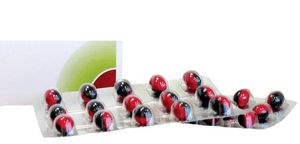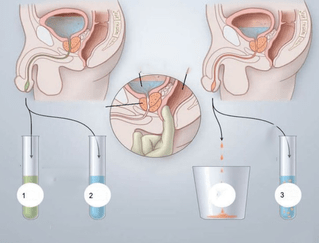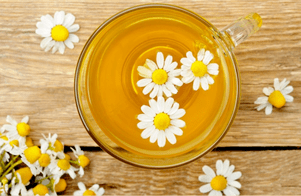
Chronic prostatitis is an inflammatory disease characterized by lesions of the prostate gland and severe urodynamic disorders. One of the causes of chronic prostatitis is due to improper or untimely treatment in the acute phase, when the sloughing and proliferation of the adenocarcinoma is reversible and successfully treated. drug within 2-3 weeks.
Treatment for chronic prostatitis includes massive antibiotic therapy aimed at destroying infectious agents, a range of measures to increase the body's immune resistance, physical therapy, heat therapy. Psychological correction may also be included in the treatment regimen, as conditions like neurasthenia and neurological disorders are often observed in men with long-term and recurrent prostatitis.
Why does inflammation become chronic?
Knowing the cause of chronic prostatitis is essential to preventing exacerbations and improving the patient's quality of life. There is a large number of factors that can influence the functional state of the glandular (glandular) tissue of the prostate gland and cause its inflammation, based on the sloughing and proliferation of epithelial cells. .
The main cause of chronic prostatitis in men is extensive contamination of the mucous membrane of the genitourinary system by pathogenic microorganisms. In the majority of cases (more than 80%) infectious prostatitis, gram-negative and gram-positive bacteria become infectious agents: intestinal bacteria (especially Escherichia coli), gonococci, staphylococci. Usually, the infectious and inflammatory process progresses against the background of viral, fungal and protozoa infections, but such forms of prostatitis are treated fairly successfully in the acute and rarely recurring stage, subject to correct and timely treatment.

It should also be noted that in order to develop into chronic aseptic prostatitis, only an acute episode of infection in the urinary tract is sufficient, so personal hygiene, use a condomLatex during sexual intercourse and timely treatment of urinary tract diseases are very important in the prevention of this disease in men. Medicine knows cases of sepsis (through complete circulation of the body) of the prostate gland in chronic sinusitis, tonsillitis and other diseases that contribute to the active development of pathogenic flora, thus, restoration of chronic foci of infection is an important stage in complex treatment for persistent or persistent prostatitis.
The negative factors that can cause an exacerbation of prostatitis (including a non-infectious process) are:
- injuries to the urinary tract and surgery to organs of the genitourinary system;
- frequent or severe hypothermia of the pelvic organs (swimming in open tanks during times of not warm enough water or cool outside weather, working in refrigerators and freezers, etc. );
- lowered motivation due to a man's sedentary work and inadequate physical activity (sedentary lifestyle is one of the major factors in the development of cognitive chronic prostatitis);
- bad habit, in which the absorption of the most important trace and macro elements determines the chemical composition and rheological properties of prostate secretion (zinc, chromium, selenium, manganese). slowing down or slowing down;
- disorders in the intimate sphere (frequent masturbation, infrequent sexual intercourse, long-term abstinence, frequent stimulation that does not end with sex);
- overweight;
- eating disorders (increased consumption of spicy, overly salty, smoked and fatty foods).
Pay attention! The leading pathogenesis factor that develops into chronic prostatitis is posterior urethritis, noted by urologists. It was also noted that inflammatory changes in the prostate gland in men appear during the first months after a urinary tract infection.
Treatment of chronic prostatitis with drugs
Treatment of chronic prostatitis with drugs is intended only to prevent the acute symptoms during the exacerbation and destroy the infection, but the drug cannot be used as the only means (the effect ofSuch treatment will not exceed 36%, according to Dr. Pechersky).
A complete treatment regimen for persistent or recurrent prostatitis, used today as a standard for uncomplicated disease, is shown in the table below.
Table. Preparations for the complex treatment of chronic prostatitis.
| Pharmacological group | Purpose of the Application |
|---|---|
| Antibiotics from the macrolide group, semi-synthetic penicillins and third generation cephalosporins with broad antimicrobial activity. | Eliminates (destroys) pathogenic bacteria - agents that cause infectious prostatitis, urethritis, cystitis and other urinary infections. |
| Antimicrobial and anti-protozoa. | Treatment of infections caused by pathogenic bacteria and protozoa. |
| Nonsteroidal anti-inflammatory drugs (preferably in the form of rectal suppositories). | Reduces inflammation in the tissues of the prostate gland, reduces pain in the perineum, space between the fetus, sacrum and groin. |
| Antiseptic in the form of rectal suppositories. | Restores rectal mucous membranes and prevents infection caused by prolonged prostatitis. |
| Alpha blocker. | Normalizes urination, restores daily urine output. |
| Microcirculation regulator. | Eliminates the blockage in the vessels of the small pelvis, restores normal blood and lymph flow. |
| Urodynamics modulator (agent that affects metabolism in prostate tissues). | Improves metabolic and metabolic processes in the tissues of the prostate gland and its nutrition. |
| Effect regulator. | Treatment of erectile dysfunction complex, improvement of chemical composition, semen viscosity and fluidity, increased sperm activity (indications for the use of this class for patients with prostatitis havecomplications of autoimmune infertility). |

The duration of antibiotic treatment is at least 4-6 weeks. In any case, you should not take drugs with an antibacterial effect without the prescription of a doctor, as the leading factor in the choice of therapy is the result of the microscopic examination of the substances. Prostate secretion and natural secretion from prostate massage. Some antibiotics, for example, penicillins (the combination of amoxicillin with clavulanic acid) are reserve drugs, and their incorrect use may not only result in a clinically insignificant effect andprogression of the pathology that also leads to the development of superinfection.
Important! In some cases, men with chronic prostatitis need psychological correction, especially if pain syndrome is associated with behavioral changes, increased anxiety, irritability, and nervous breakdown. Antidepressants with selective serotonin reuptake inhibitors are used to prevent these symptoms.
Physiotherapy
Heat therapy is the primary treatment for chronic prostatitis outside of the exacerbation phase (after recovery of acute symptoms). Thermotherapy refers to methods of physical therapy and is a dosing thermal effect on the affected area. The benefits of thermal procedures are the normalization of blood circulation, reduction of inflammatory processes, relief of chronic pelvic pain, one of the main clinical manifestations of chronic prostatitis, reducing the quality of life ofmale. Heat also improves the penetration of the drug into the prostate tissue, so in some cases physiotherapy is used to increase the effectiveness of drug therapy (for example, electrophoresis with antibiotics. ). For men at high risk of formation of blood clots, heating is prescribed as prophylaxis, since heat has a moderate restorative effect.
There are a large number of methods that exert heat on the body, and the selection of a particular treatment should be made by the physician, taking into account the clinical profile, type and stage of thedisease, man's age and individual stamina. The most effective thermal treatments for prostatitis are:

- thermal application
- with minerals (ozokerite, paraffin, bischofite), salt or sand;
- electric heating pads;
- deeply heats high-strength tissues to act directly on blood vessels and nerve endings (diathermy);
- is exposed to high frequency alternating magnetic fields to eliminate pain, reduce inflammation and eliminate neurotic-like manifestations (heat induction); Ultrasound therapy
- (promotes resorption of abscesses and healing of already formed scars);
- electrophoresis with the introduction of electrodes into the rectum;
- is exposed to prostate tissue by high frequency pulse current (darsonvalization).
In some physiotherapy rooms, chronic prostatitis is treated with hot mud applications ("mud pants"). Such procedures have a positive effect not only on blood and lymph circulation but also on the production of prostate secretions, as well as on tissue nutrition of the inflamed organ. In some cases, the sludge is injected directly into the rectum in the form of a tampon, because with this method of use it is possible to quickly achieve a therapeutic effect and a positive response to the therapy.
Other treatments
A complex treatment plan, in addition to drug and heat therapy, is complemented by various procedures prescribed by the doctor, taking into account the peculiarities of the pathology in each case.
Prostate massage
This is one of the main methods of treating chronic prostatitis, and is recommended for almost 90% of cases (in the absence of contraindications). Massage is the action of a finger on the prostate gland to stimulate secretions. The duration of the procedure is usually about 1-2 minutes. The criterion for an adequate effect is complete emptying of the prostate gland, for which the patient feels relieved (which he should inform the doctor about).

The benefit of massage is determined by the efficacy that can be achieved after one course of treatment (8-12 courses). For a straightforward course, this is:
- normalizes muscle tone;
- improves blood circulation in the vessels of the prostate gland (therefore, the transport of substances into the tissues of the affected organ is accelerated and increases the effectiveness of treatment);
- restores secret rights;
- normalizes the outflow of blood and lymph from the prostate gland (especially significant in cognitive prostatitis).
The procedure is contraindicated in the acute phase due to the high risk of infection to surrounding tissues and organs (sepsis), with other infectious diseases of the genitourinary system, with cysts or internal stones. Prostate. Prostate massage is not indicated for patients who have been diagnosed with tuberculosis, adenoma or other cancers (including cancerous lesions of the prostate gland). In cases of anal rectal diseases (hemorrhoids, anal fissures, ovarian inflammation, adnexitis), massage can cause complications and a relapse of the underlying disease.
Important! Studies show that nearly 42% of men refuse to massage the prostate due to psychological discomfort associated with this particular procedure. The physician's work with these patients should include detailed information about the consequences of the refusal of treatment and possible complications, especially infertility and persistent sexual dysfunction. In some cases, a mild sedative may be prescribed a few days before starting treatment.
Hot enema
Hot enema is a home remedy for chronic prostatitis, but urologists recognize their effectiveness and recommend them to treat prostatitis faster. and more efficient. The water temperature for these enemas should be about 42 ° C. Before the procedure, it is necessary to clean the bowels with a regular enema or laxative. The volume of one enema is between 150 and 300 ml. It is recommended to have a bowel movement 30-50 minutes after using the solution.

Prescriptions for chronic prostatitis are listed below.
- Dissolve 10 drops of iodine and about 20 ml of chlorhexidine in 200 ml of water. Apply at bedtime for 15 days.
- It is recommended to bring water color from chamomile, St. seaweed. John or calendula enters the rectum (about 250 ml), and then hold it for 1 hour. The procedure is repeated once a day for 2 weeks.
- Sea buckthorn oil (40-50 ml) is heated to 40 ° C and injected into the rectum for 20-30 minutes. The course of treatment is 10-15 days. This procedure is best done before going to bed.
- In the case of a severe pain syndrome, which significantly limits a patient's mobility and reduces their quality of life, microclyster with novocaine can be used. Dissolve 2 ampoules of 2% novocaine in 180 ml of chrysanthemum concentrated water. Hold for at least 50 minutes. Repeat daily for 1 week.
Anti-inflammatory drugs, antiseptics, antibiotics can also be used from drugs for bacteria. The use of these drugs is allowed with the permission of the doctor in exactly the indicated dosage.
Treatment of chronic prostatitis: step-by-step instructions
The use of many different treatments is not enough to completely cure chronic prostatitis. If a man does not monitor his diet and does not change his lifestyle, exacerbations will occur frequently, leading to irreversible changes in the structure and functioning of theprostate and sexual disorders and intermittent disorders. For greater effectiveness and duration of remission, you should follow the recommendations outlined in the following guidelines for patients with chronic prostatitis.

- Step 1. If a man is diagnosed with chronic prostatitis, he should start by adjusting his diet. Exclude from the menu foods high in fat, salt and spices. Fat raises cholesterol levels in the blood, and salt promotes fluid retention and edema in prostate tissue. Spices (like various chemical additives) irritate the mucous membrane of the urinary tract, aggravating existing symptoms.
- Step 2. It is also necessary to completely eliminate alcoholic beverages, as they slow down nutrient absorption, disrupt blood and lymph circulation, negatively affect the metabolism in the frontlineparalysis. If a man suffers from a smoking addiction, it is necessary to take measures to quit this habit (toxic substances in cigarette smoke disrupt viscosity and fluidity of prostate secretions and change chemical composition. its school).
- Step 3. Overweight men should consult an endocrinologist and nutritionist for a comprehensive diagnosis and adjustment of body weight, taking into account identified deviations. Obesity is the most important factor in the development of chronic prostatitis, and a key stage in complex therapy is weight loss in patients with a high BMI.
- Step 4. To eliminate the inertia associated with dynamics, a sufficient level of physical activity should be provided, corresponding to age and fitness. Swimming, physical therapy exercises, stretching exercises, and walking are very helpful for prostatitis.
- Step 5. For the prostate to function properly, the quality of your sex life needs to be monitored. It is advisable to have a long-term sexual partner, avoid episodes of sexual arousal if unable to have sex, and regularly check for genital infections, which can also cause exacerbations of chronic prostatitis.
Men with recurrent prostatitis need to watch for stress, avoid stressful situations as well as prolonged exposure to cold or drafts.
Chronic prostatitis is a difficult disease to treat, especially if the patient does not follow the instructions of the attending physician and does not have a responsible approach to nutrition and diet. Prostatitis is dangerous with serious complications, so you need to approach the problem comprehensively. Men with this diagnosis should understand that medication alone is not enough to fully restore all functions of the prostate gland, so basic treatments for prostatitis should not be abandoned. Chronic paralysis is recommended by a doctor, even if they cause psychological or physical discomfort.































